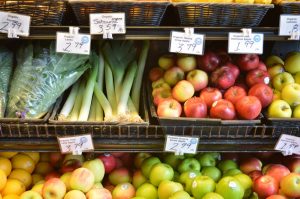Veganism and Sustainability
by Ava Jones, Student in SEE-U NYC: Agro-eco/Food Systems Course

For many people, there has been a more recent and more focused attention put on where our food comes from and how it is impacting the strained environment we’re all living in right now. This should be seen as a good thing for the everyday consumer, as previously standard consumption practices were wasteful and provided little healthy and sustainable nutrients to the buyers. Food was and is still generally heavily processed, wrapped in plastics, and shipped extremely far from where they were sourced. This doesn’t even get into the poor environmental practices seen in industrial meat and dairy production, with unsanitary and inhumane living and slaughtering conditions for both animals and workers. Because there has been a push for increased attention on where our food is coming from, many people have decided to just go cold turkey (cold…. Tofurkey?) and cut out meat, meat and fish, or all animal products including dairy, eggs, and honey. In households and in the restaurant world the vegan diet consists of eating fruits, vegetables, grains, and other sources of vegan nutrition all year round. This diet is often lauded as healthier for the environment as well as the mind and the body. But is it really?
It’s normal to have cravings and want to have a mango smoothie in the month of February or stone fruits in winter months and winter vegetables during the summer time. This is the kind of food convenience our society has become accustomed to, and it’s generally hard to remember that this isn’t natural. Especially considering vegetarian and vegan diets, it’s easy to forget that the same bunch of workers that labor on animal production sites are the same as the migrant workers found in industrial farming of grains, fruits, and vegetables. Large corporations often use heavy pesticides that find their ways into the lives of the workers and their families. Shipping lettuce from California or bananas from South America requires not only plastic-heavy packaging, but also requires that the food is actually shipped to America, often in large trucks that use up enormous amounts of gas and emit high levels of greenhouse gases. Once it’s in a Whole Foods or served up on your plate in a restaurant, it’s hard to see the food’s history the same way you can see the history through a slab of meat in Styrofoam and plastic wrap.
Just because it’s harder to see doesn’t mean the history isn’t there. This topic is hard to critique because of course people need their necessary nutrients and why shouldn’t they? Especially when trying to be environmentally conscious, it’s easy to get overwhelmed and forget what your original concerns were. Ideally, it would be important to source your grain and fruits and vegetables and other forms of protein only seasonally, but so many people all over the world don’t have access to fresh food and can hardly make the sacrifice to cut out cheap and protein heavy options.
The solution? There might not be an obvious one. In an ideal world, maybe seasonal urban farms located all over the world with the understanding that the practices are sustainable, organic, and thrive on the goal to serve the community. So of course, it’s complicated. There are so many intersections between our lives and food and sustainability and food that it’s easy to get lost. Veganism and vegetarianism may have the right idea, but we may not have access to the right knowledge and resources and tools necessary to make an actual impact on how our current lives interact with the food systems we depend on.
References
Pendergrast, N., 2015. Environmental concerns and the mainstreaming of veganism, in: Raphaely, T., and Marinova, D. (Eds.), Impact of Meat Consumption on Health and Environmental Sustainability Practice, Progress, and Proficiency in Sustainability, IGI Global, pp. 106–122.
Beardy, A., 2015. Finding the Future of Food: Sustainable Consumption Lessons from and for Veganism. Doctoral Thesis. Arizona State University, Temple, AZ, USA.




Submit Comment